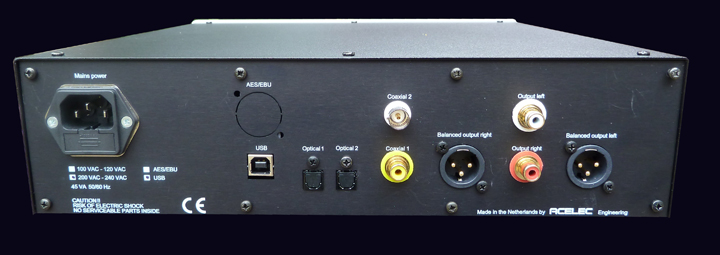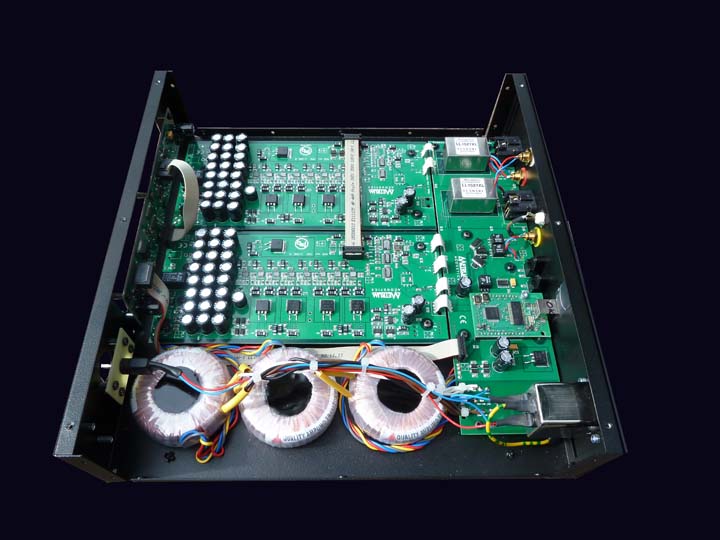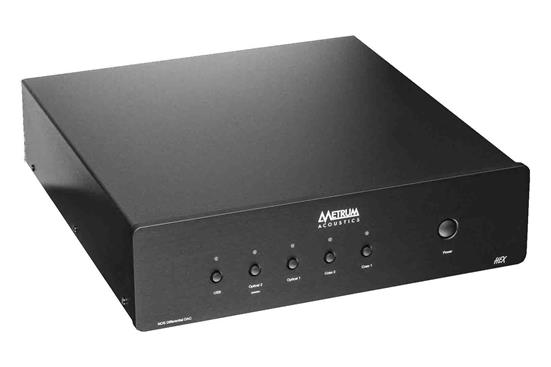After a relatively pleasant year with my Bryston BDA-2 DAC, I noticed something a little weird. Some of my favorite albums weren’t getting played as much as they usually did. I absolutely love Led Zeppelin’s Physical Graffiti and Bruce Springsteen’s Born to Run, but I hadn’t listened to them for a long while. Then it hit me, these two amazing albums were typical 1980-90s masters, basically on the brighter side of things and sounded quite “digital” to my ears. And the BDA-2 only seemed to exacerbate things to the point where I was picking music that it paired with better. While I still hold the Bryston DAC in high regards for detail retrieval and clarity, some recordings, when played through CDs and USB, came off a bit too digital sounding.
Around the same time, I hadn’t noticed that my six-year old son had turned off the upsampling feature on my BDA-2. When I bought the DAC a year ago, I briefly played with this setting, but quickly decided on keeping the upsampling “ON” and then I moved to better things. Almost immediately I noted a more natural sound coming through my system. The treble that sometimes bothered me with specific recordings seemed to have diminished and the music seemed to flow with more a bit more ease. Upon a quick look over of my setup I quickly noticed that one of the buttons on my BDA-2’s front panel was not illuminated. And sure enough, it was the upsampling option. As soon as I turned it back on, I noticed that the edginess was back and the sound staging seemed narrow. So back and forth I went between these two options and I came to the conclusion that I actually preferred the sound with the upsampling turned off. Why had I missed this during the initial setup? Likely, my assumption that upsampling to 192kps was just better (the higher the number…). But sonically, my ears were now telling me something completely different.
So then I started to research more in-depth NOS DACs (Non-OverSampling DACs). In short, NOS DACs are digital to analog converters that take a more purist approach and do not oversample the music bitrate (basically add anything the recording that wasn’t there in the first place). My search very quickly led me to the Metrum Acoustics Hex DAC. Metrum Acoustics is a company founded in The Netherlands and is the manufacturer of the critically acclaimed Metrum Octave digital-to-analog converter. The Hex is their top of the line DAC that was released in late 2012. Having heard the Octave (Mk1 version) and being very impressed with its very natural sound, the Hex seemed like a strong candidate for my needs.
Amazingly, the Hex employs a whopping sixteen DAC chips (eight per channel) that run at an impressive (and rather overkill) 24Bits/15MHz. But when it comes to high end audio, overkill is sometimes what you want. There are a total of three toroidal transformers in order to fully separate the all of the DAC’s boards. There are two 75ohm SPDIF inputs (one BNC and one RCA), two Optical Toslink inputs, and options for an asynchronous USB 2.0 input, an AES/EBU module. The Hex outputs standard RCA (x2) (unbalanced) and balanced XLR (x2). After reading through the design and build of this DAC and some promising reviews, my interest was piqued to say the least.
Around the same time, I was able to find a slightly used, mint condition Metrum Hex on sale from a relatively local vendor on Canuck Audio Mart. I received the unit the next day. The first thing that grabbed me was just how solidly built the Metrum Hex is. It comes in at a hefty 5.5kg and the aesthetics are clean and streamlined. The front panel allows the user to quickly change between sources with the push of a single button. If the source isn’t connected, the light blinks to indicate that the source is not “ON” or engaged. Setting up the Metrum Hex was a snap, I just put in in my rack, plugged in my CD transport (Cambridge Audio 650C CD player) via SPDIF, my iMac via USB and the power and I was done. Being an NOS DAC, it certainly makes setup easy without having to worry about sampling rates, filters, et cetera.

For this evaluation I primarily used my Sennheiser HD800’s, Stax SR-009’s and Audeze LCD-X headphones. My amplifiers were the HeadAmp GS-X Mk2, the Cavalli Audio Liquid Lightning II and a DIY KGSSHV (an electrostatic headphone amplifier designed by the famed designer Kevin Gilmore). Upon first listen I was immediately surprised at how much wider and deeper the sound staging was over many other impressive DACs I’ve experienced. The Bryston BDA-2, NAD M51 and PS Audio Perfect Wave 2 all had similar soundscapes, but the Metrum Hex brought this to a whole new level. I’ve always been impressed with how the Sennheiser HD800’s can sound like speakers, but I wasn’t fully aware that they were this darn good and capable of rendering such an expansive soundscape. The second thing that immediately got me excited was how natural the Metrum DAC sounded. The music simply flowed. I certainly would not describe the sound signature of the Metrum Hex as “digital”, but rather “natural”. Some reviewers have noted it as more “analog” than most DACs and I have to agree.
First up were a few of my favorite classical recordings. I find classical music a great test for a new DAC. Typically there’s a lot going on with various instruments playing at the same time, their location in the orchestra, and so many micro details can be harvested with a great setup. One of my “go to” classical albums is Aaron Copland’s Fanfare for the Common Man: Symphony #3, by Eiji Que and the Minnesota Orchestra. Simply put, I heard things with this recording that my other DACs seemed to have missed. Ever so minute tidbits were now being picked up by my HD800/GS-X Mk2 setup that the BDA-2 or M51 seemed to gloss over completely. I could hear individual string picks of the cello or violin by the musicians and the extra reverberations of the tympani were all clearly present, but they were also in the proper proportion to the rest of the recording. It was as if I was in Roy Thompson Hall here in Toronto, watching the Toronto Symphony Orchestra play. The ability of the Metrum Hex to incorporate even the smallest nuances into the music and not come off as clinical was a surprise for me. While this did not initially jump out at me, over a few weeks with this DAC I was completely in awe of this ability. Previously I thought you couldn’t have both at the same time. I guess I was wrong? The trumpets sounded sublime. I’ve played trumpet for over 30 years and with the Hex, I could hear the timbre of this instrument with a spooky realism that left me with goose bumps. And unlike many previous upsampling DACs that I’ve owned and heard, there was no hyper-realism, nor glare, nor aggressive treble that can masquerade as artificial detail. Instead the music flowed naturally and the presentation sounded like I was there in the concert hall.

The bass, midrange and treble were all balanced in perfect harmony; the imaging was breathtaking and accurately placed in the sound stage and the details were rendered faithfully and often times had me believing I was literally there. I suppose the best analogy I can come up with is that with the Bryston BDA-2 (or NAD M51), it was like watching the concert through a vivid high definition 240MHz LCD HDTV. The colors were vibrant and clear, but in the end, it seemed like a hyper-reality where the reds were just a bit too red, and the blues were just a bit too blue and the vividness and sharpness was just too much. While on the Metrum Hex, it was as simple as watching the concert through an open window and with a realistic experience.
The bass presentation on “El Camino” by The Black Keys was hard hitting, tactile, deep and ethereal – more than enough to satisfy the most critical listener with my Audeze LCD-X headphones. “Lonely Boy” thumped with a vivid realness that left me speechless. I found the bass was a bit rounder and fuller with the Hex; more so than other DACs I’ve heard or owned, but this fullness never lingered more than required and offered details in that fullness that were not presented well with the competition. I could hear small reverberations and vibrations down low that had me bobbing my head with complete satisfaction.
The midrange was equally up to the task of presenting a completely cohesive and realistic portrayal of the music. To test both male and female voices, I threw Andrea Bocelli’s “Passione” and Diana Krall’s “The Look of Love” at the Metrum Hex and the results were impressive. Both Andrea’s and Diana’s voices were up-front and center with my SR-009/Liquid Lightning 2 combination. The balance between the mid range and the bass and treble was pretty much perfect to my ears. The Bryston BDA-2 had a slightly more fun sounding “U” shape where the bass and treble were slightly elevated over neutral. Initially this was enthralling, however, next to the more natural sounding Metrum Hex, it was blatantly obvious which DAC was the more balanced sounding option. The Bryston DAC had selected to go with the more vivid presentation that would grab the listener’s attention immediately, while the designers of the Hex went with the more “real” sounding option. There was no initial “wow” factor, but over the past few weeks, I have come to very much appreciate the genuineness of the neutral presentation and going back to the hyper-realistic version of reality was rather difficult.

I think the upper registers of the Metrum Hex are some of the most spectacularly presented from a digital source that I’ve ever heard. It was as if I was back in the 1980s, and I had my LP collection with me (which has been in cold storage for the better part of two decades). I was an early adopter of CDs (being a young and foolish teenager) and over the past 25 years, I’ve amassed quite a large collection. However, with the digital age of convenience came overzealous treble. I suppose the thinking was that a sense of more detail could be portrayed with more treble? But in the end, this does not sound natural to me and can be fatiguing when listening to over several hours. Pretty much every CD player or DAC I’ve owned through the years has suffered from this, to some extent. But after only a few days with the Metrum Hex, I can easily assert that this syndrome of “digititus” is no longer a factor. The Hex presents treble that is clearly extended, but natural at the same time. Triangles sound like triangles with amazing clarity and detail, cymbals echo and decay as they do in real life; and all without causing the listener’s eyes to cross with stridency in the treble region. Quite simply, the Metrum Hex presents treble the most accurate and closest to “real life” that I’ve heard from a digital source.
While not cheap – costing a hefty $3500 USD – the Metrum Hex has transformed my digital listening experience. No longer do I have to avoid early 1980’s-1990’s albums for their overly “digital” sound. Instead, I can enjoy the full breadth of my music collection with the ease of mind knowing that I can simply sit back and let the music flow. The expansive sound stage has me amazed at just how much more detail there was in my recordings that my other DACs missed. Not to mention that the naturalness of the sound has left me completely satisfied. The solid, though utilitarian, construction has me impressed with my purchase. The sonics of the Hex, however, have me thoroughly delighted with my music.















Reply
Want to join discussion?
Feel free to contribute!